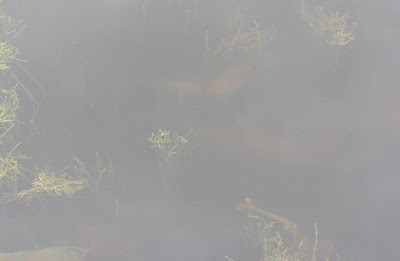We went almost to the top of Shropshire when we visited this site. Only on Stiperstones and Brown Clee could we have got any higher.
The first thing that strikes you when reaching the car park is the excellent view, even in the changeable weather that greeted as we arrived.
 |
| South west from the car park |
The second is how much of the landscape has been shaped by human activity, from the sculptured hillside as a result of quarrying to the remains of buildings.
As we surveyed the extensive quarrying we pondered what the hill would have looked like in times past.
I was "caught" in the act of taking the above photographs
 |
| Photograph: David Williams |
As I walked to catch up the others I noticed a half buried cylindrical metal thing.
Checking this I found that there was a round hole in the top and there was life inside.
I caught up the rest at the entrance to the quarry just as one of the group was pointing out something in the pool
What had he seen of such great interest?
Here it is
Can you make it out?
Here's a clue - I've highlighted the outline of the object in the water.
Yes, someone had dumped a car in the pool.
Back to wildlife! An angle shades moth was found on thistle
Although the moth is clearly visible in the photograph it is quite an effective camouflage when giving the thistle a quick glance.
The quarry is huge
 |
| Photograph: David Williams |
 |
| Photograph: David Williams |
 |
| Photograph: David Williams |
To take the photograph I lay prone on the quarry floor. This caused much amusement to one of our snappers who regularly gets into unusual positions to take that perfect shot.
Passing the car park we found bank that was covered in Carline thistle. The happy snapper encouraged me to take a landscape shot.
"Won't most of it be out of focus?" I asked innocently
"Set the camera to f8. That will give you the better depth of field" was the reply
"And do it as a portrait" was added
Not having a clue what 'f8' meant, but knowing it was a setting on the camera I did as instructed and here is the result.
As we walked along we were able to enjoy the view to the west and be thankful we were not under the downpour visible in the distance.
 |
| Photograph - Dave Williams |
At last we made it to the scree slope which was caused by and has remained intact since the last ice age.
Amongst the bracken and gorse that had invaded the scree a single tall plant with large yellow flowers stood out.
A Perennial sow-thistle.
We investigated the slope for some time
Excitement mounted as we found Lichenomphalia umbellifera which, I am told, is one of the very few gill fungi associated with lichen.
 |
| Photograph: Bob Kemp |
 |
| Photograph: David Williams |
One advantage of a commanding view is you get advance notice of the weather. The large clouds in the far distance got nearer and darker. It was time to retreat.
On the way we came across a clearing. I had a quick look around and found a lichen on a rock that looked as though it had been painted rather than grown.
I am told this may be Porpidia macrocarpa. It forms on flat surfaces and the orange staining is caused by the iron in the rock.
On that artistic note we left just as the threatening clouds and their accompanying deluge arrived. Good timing?
My thanks to Shropshire County Council for granting us permission to survey; to David Williams and Bob Kemp for the additional photographs.










































No comments:
Post a Comment
Please feel free to comment on this post...